
(a)
Interpretation:
Synthesis of
Concept introduction:
Synthesis is the process of conversion of one compound into another using reagents. For the conversion of one compound into another, multiple number of steps undergoes using multiple reagents.
Answer to Problem 20.47AP
Synthesis of
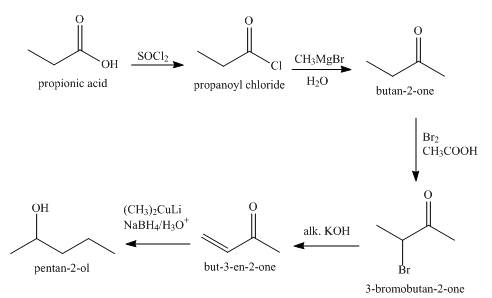
Explanation of Solution
The synthesis of

Figure 1
The total number of steps in the synthesis are five. In the first step propanoic acid is converted into acid chloride which is converted into
The ketone
Synthesis of
(b)
Interpretation:
Synthesis of the given compound from allyl alcohol using appropriate reagents is to be stated.
Concept introduction:
Synthesis is the process of conversion of one compound into another using reagents. For the conversion of one compound into another, the multiple numbers of steps undergo using multiple reagents.
Answer to Problem 20.47AP
Synthesis of the given compound from allyl alcohol using appropriate reagents is shown below.
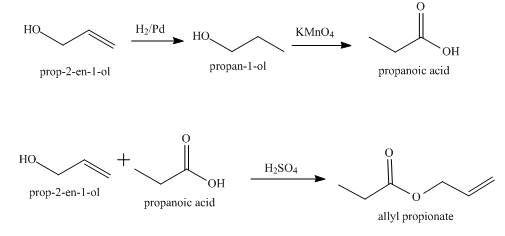
Explanation of Solution
The given compound to be synthesized is shown below.

Figure 2
The synthesis of the given compound from allyl alcohol is done using multiple steps shown below.

Figure 3
The allyl alcohol,
Synthesis of the given compound from allyl alcohol using appropriate reagents is shown in Figure 3.
(c)
Interpretation:
Synthesis of
Concept introduction:
Synthesis is the process of conversion of one compound into another using reagents. For the conversion of one compound into another, the multiple numbers of steps undergo using multiple reagents.
Answer to Problem 20.47AP
Synthesis of
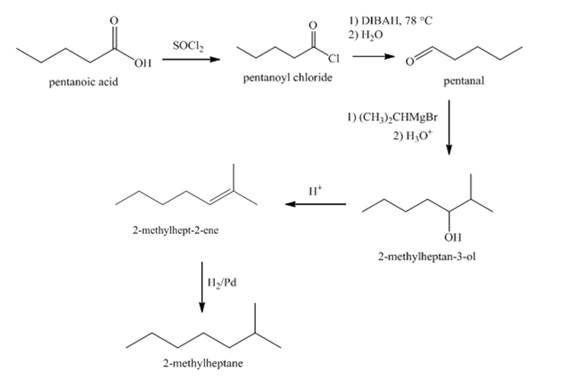
Explanation of Solution
The synthesis of

Figure 4
The conversion of pentanoic acid to acid chloride is done by using thionyl chloride. The acid chloride thus produced is reacted with DIBAH at
Synthesis of
(d)
Interpretation:
Synthesis of
Concept introduction:
Synthesis is the process of conversion of one compound into another using reagents. For the conversion of one compound into another, the multiple numbers of steps undergo using multiple reagents.
Answer to Problem 20.47AP
Synthesis of

Explanation of Solution
The synthesis of

Figure 5
Toluene is first oxidized using potassium permanganate to give benzoic acid. A carboxylic acid group is a meta-directing group. The benzoic acid is then nitrated to give
Synthesis of
(e)
Interpretation:
Synthesis of
Concept introduction:
Synthesis is the process of conversion of one compound into another using reagents. For the conversion of one compound into another, the multiple numbers of steps undergo using multiple reagents.
Answer to Problem 20.47AP
Synthesis of
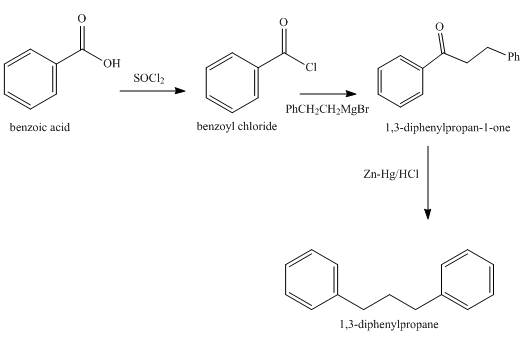
Explanation of Solution
The synthesis of

Figure 6
Benzoic acid is converted into benzoyl chloride in the first step which is then reacted with Grignard’s reagent to give an appropriate ketone which on Clemmensen reduction gives the required product
Synthesis of
(f)
Interpretation:
Synthesis of given
Concept introduction:
Synthesis is the process of conversion of one compound into another using reagents. For the conversion of one compound into another, the multiple numbers of steps undergo using multiple reagents.
Answer to Problem 20.47AP
Synthesis of given

Explanation of Solution
The synthesized compound is

Figure 7
Synthesis of given

Figure 8
The
Synthesis of given
(g)
Interpretation:
Synthesis of given dicarboxylic acid from norbornene using appropriate reagents is to be stated.
Concept introduction:
Synthesis is the process of conversion of one compound into another using reagents. For the conversion of one compound into another, the multiple numbers of steps undergo using multiple reagents.
Answer to Problem 20.47AP
Synthesis of given dicarboxylic acid from norbornene using appropriate reagents is shown below.

Explanation of Solution
The given dicarboxylic acid is shown below.
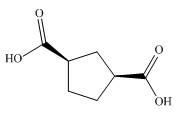
Figure 9
Synthesis of given dicarboxylic acid from norbornene using appropriate reagents is done in a single step shown below.

Figure 10
The conversion of norbornene into the required dicarboxylic acid is done in a single reaction. The ozonolysis of norbornene with oxidative work gives the required product.
Synthesis of given dicarboxylic acid from norbornene using appropriate reagents is shown in Figure 10.
(h)
Interpretation:
Synthesis of
Concept introduction:
Synthesis is the process of conversion of one compound into another using reagents. For the conversion of one compound into another, the multiple numbers of steps undergo using multiple reagents.
Answer to Problem 20.47AP
Synthesis of
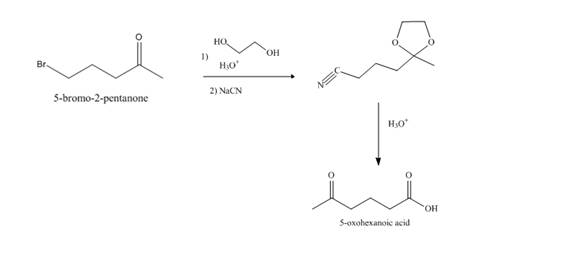
Explanation of Solution
Synthesis of

Figure 11
The compound,
Synthesis of
(i)
Interpretation:
Synthesis of
Concept introduction:
Synthesis is the process of conversion of one compound into another using reagents. For the conversion of one compound into another, the multiple numbers of steps undergo using multiple reagents.
Answer to Problem 20.47AP
Synthesis of
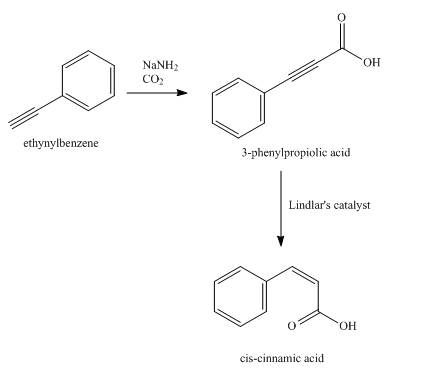
Explanation of Solution
Synthesis of

Figure 12
The compound,
Synthesis of
Want to see more full solutions like this?
Chapter 20 Solutions
ORGANIC CHEMISTRY SAPLING ACCESS + ETEX
- CUE COLUMN NOTES (A. Determine Stereoisomers it has ⑤ Identify any meso B compounds cl Br cl -c-c-c-c-¿- 1 CI C- | 2,4-Dichloro-3-bromopentanearrow_forwardThe acid-base chemistry of both EDTA and EBT are important to ensuring that the reactions proceed as desired, thus the pH is controlled using a buffer. What percent of the EBT indicator will be in the desired HIn2- state at pH = 10.5. pKa1 = 6.2 and pKa2 = 11.6 of EBTarrow_forwardWhat does the phrase 'fit for purpose' mean in relation to analytical chemistry? Please provide examples too.arrow_forward
- For each of the substituted benzene molecules below, determine the inductive and resonance effects the substituent will have on the benzene ring, as well as the overall electron-density of the ring compared to unsubstituted benzene. Molecule Inductive Effects Resonance Effects Overall Electron-Density × NO2 ○ donating O donating O withdrawing O withdrawing O electron-rich electron-deficient no inductive effects O no resonance effects O similar to benzene E [ CI O donating withdrawing O no inductive effects Explanation Check ○ donating withdrawing no resonance effects electron-rich electron-deficient O similar to benzene © 2025 McGraw Hill LLC. All Rights Reserved. Terms of Use | Privacy Center Accesarrow_forwardUnderstanding how substituents activate Rank each of the following substituted benzene molecules in order of which will react fastest (1) to slowest (4) by electrophilic aromatic substitution. Explanation HN NH2 Check X (Choose one) (Choose one) (Choose one) (Choose one) © 2025 McGraw Hill LLC. All Rights Reserved. Terms of Use | Privacy Center Aarrow_forwardIdentifying electron-donating and electron-withdrawing effects on benzene For each of the substituted benzene molecules below, determine the inductive and resonance effects the substituent will have on the benzene ring, as well as the overall electron-density of the ring compared to unsubstituted benzene. Inductive Effects Resonance Effects Overall Electron-Density Molecule CF3 O donating O donating O withdrawing O withdrawing O no inductive effects O no resonance effects electron-rich electron-deficient O similar to benzene CH3 O donating O withdrawing O no inductive effects O donating O withdrawing Ono resonance effects O electron-rich O electron-deficient O similar to benzene Explanation Check Х © 2025 McGraw Hill LLC. All Rights Reserved. Terms of Use | Privacy Centerarrow_forward
- * Hint: Think back to Chem 1 solubility rules. Follow Up Questions for Part B 12. What impact do the following disturbances to a system at equilibrium have on k, the rate constant for the forward reaction? Explain. (4 pts) a) Changing the concentration of a reactant or product. (2 pts) b) Changing the temperature of an exothermic reaction. (2 pts) ofarrow_forwardDraw TWO general chemical equation to prepare Symmetrical and non-Symmetrical ethers Draw 1 chemical reaction of an etherarrow_forwardPlease help me with the following questions for chemistry.arrow_forward
